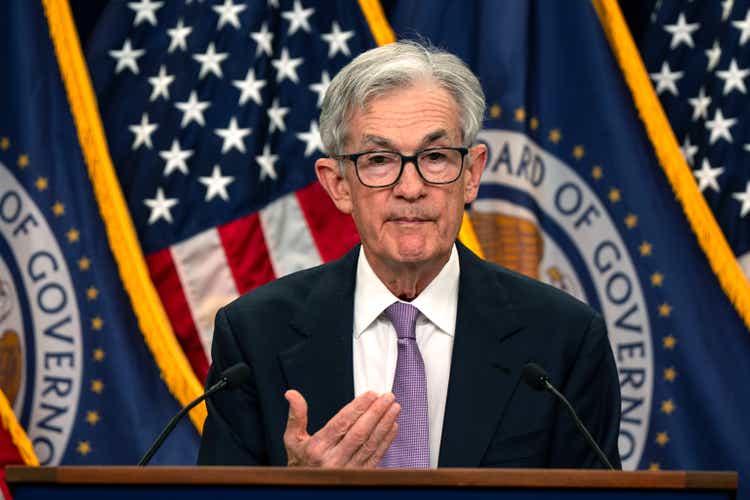
Kent Nishimura/Getty Images News
The U.S. Federal Reserve on Thursday delivered a quarter-point interest rate cut, as widely expected, citing risks to achieving its dual mandate as “roughly in balance.”
The Federal Open Market Committee (FOMC) cut the federal funds rate by 25 basis points to 4.50%-4.75%, the lowest level since February 2023. The action follows the central bank’s bumper 50 basis point rate cut in September.
Fed chair Jerome Powell in his post-decision press conference praised the strength of the U.S. economy. He also fielded several questions about the implications of Donald Trump’s return to the White House, saying that the election will have no effect on policy decisions.
Wall Street (SP500) held on to huge gains from before the Fed decision and press conference, and two of the three major averages eventually ended at record levels. Here are some exchange-traded funds that track the benchmark index: (SPY), (VOO), (IVV), (RSP), (SSO), (UPRO), (SH), (SDS), and (SPXU).
See below for various reactions to the Fed’s actions:
Chris Lau, investing group leader of DIY Value Investing:
“Markets widely expected the Fed to cut rates again by 25 bps. This is consistent with Fed Chair Powell signaling to the market its rate-easing policy. This will greatly increase the public’s questioning of the reported 2% inflation rate. Regardless, it sets the precedent for 25 bps cuts after every Fed meeting throughout 2025.
From here, investors will turn their attention away from the Fed and instead watch the government’s spending. Furthermore, stock markets will react primarily to Trump tariffs, which take center stage. For example, watch for the impact of tariffs on the global automotive industry.”
Justin Purohit, Seeking Alpha analyst since 2022:
“Today’s Fed rate action was largely expected, and December’s path also seems predictable, with another likely 25-basis-point reduction. In the prepared release and Powell’s remarks, I saw little to suggest these expectations would shift. However, the outlook beyond December is less certain.
A decisive election outcome with single-party control, along with ongoing labor market uncertainties stemming from weather impacts and strike activity, complicate the economic landscape. While these uncertainties may not have been fully captured in Chairman Powell’s comments, they will nonetheless likely make it challenging for policymakers to clearly signal intentions beyond December.”
Damir Tokic, Seeking Alpha analyst since 2013:
“The most important issue discussed at Powell’s press conference was the increase in the 10Y Treasury yields (US10Y) since the September Fed meeting. Powell’s view is that 10Y yields are rising due to stronger growth expectations (real rates), rather than higher inflation expectations. Powell indicated that he would be concerned if the 10Y yields settled persistently at a higher level.
Thus, the most important indicator for the financial markets going forward is the 10Y yield, which could signal inflationary worry due to the forthcoming fiscal policy, – and limit the Fed’s normalization policy.”
Victor Dergunov, investing group leader of The Financial Prophet:
“The FOMC provided a 25 bps cut, as expected. Now, all eyes are on the December meeting and the data, which should ultimately determine whether the Fed cuts by another 25 bps in December or takes a break. I don’t believe the new administration plays a role in the Fed’s decisions yet, but if there are inclinations of higher inflation, the Fed will likely halt its easing monetary path.”
Jason Furman, former deputy director of the U.S. National Economic Council:
“In (the) most predictable event of the week, the Fed cut by 25bp. Monetary policy is going from very contractionary to reasonably contractionary. Makes sense given that inflation risks much lower than before but are still (contra the committee statement) higher than recession risks.
I expect another cut in December. But core PCE inflation likely to rise to 2.8% or possibly even 2.9%. Would make a continued process of cuts at every meeting difficult – unless job growth really stalls and unemployment starts to rise again.”
Jay Bryson, chief economist at Wells Fargo:
“Despite 75 bps of rate cuts since the September 18 policy meeting, the stance of monetary policy remains restrictive. That is, the real fed funds rate remains above most estimates of ‘neutral.’ Therefore, we look for the FOMC to ease policy further at upcoming meetings.
In our view, the FOMC will not react to potential policy changes that could be implemented by the incoming Trump administration until those policies are more fully formed. If, however, tariffs or other fiscal policies were to cause inflation to move higher next year, then we believe the nominal fed funds rate would not fall all the way toward 3%, as we had forecasted prior to the election.”
Renaissance Macro Research:
“The Fed did not lay blame on the easing in labor market conditions on the Hurricanes or Boeing (BA) strike. That’s notable. The Fed ought to focus on what they see, not speculate on what they can’t. The incoming data are more important than what’s happening in DC.”
